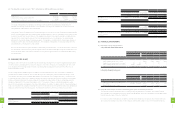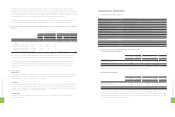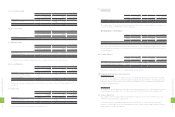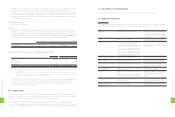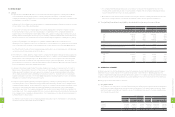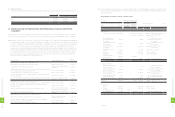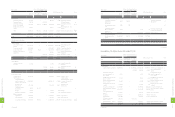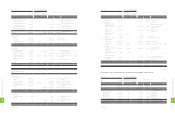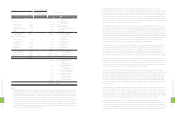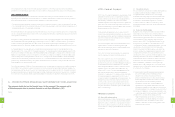HTC 2012 Annual Report Download - page 127
Download and view the complete annual report
Please find page 127 of the 2012 HTC annual report below. You can navigate through the pages in the report by either clicking on the pages listed below, or by using the keyword search tool below to find specific information within the annual report.
The Company believes that the first-time and subsequent adoption of the foregoing new and revised standards,
amendments or interpretations approved by FSC will not affect its financial statements, except in the following areas:
IFRS 9: Financial instruments
All recognized financial assets are subsequently measured in their entirety at either amortized cost or fair value,
depending on the classification of the financial assets. In addition, financial assets that meet the following conditions
are measured at amortized cost and assessed for impairment in subsequent periods:
• The asset is held within a business model whose objective is to hold assets in order to collect contractual cash flows; and
• The contractual terms on the instrument state specific dates corresponding to cash flows that are solely payments of
principal and interest on the principal outstanding.
All other financial assets are subsequently measured at fair value. However, upon initial recognition, the Company may
choose to designate a financial asset as at FVTPL if such designation eliminates or significantly reduces a measurement
or recognition inconsistency.
Investments in equity instruments are classified as at FVTPL, unless the Company designates an investment that is not
held for trading as at fair value through other comprehensive income ("FVTOCI") on initial recognition. If investments
in equity instruments are classified as at FVTOCI, except for dividends that are usually recognized in profit or loss in
accordance with IAS 18 - "Revenue," all gains and losses are recognized in OCI and will not be reclassified to profit or loss.
For financial liabilities, the main difference in classification and measurement refers to financial liabilities that are
classified as at FVTPL. Under IFRS 9 - "Financial Instruments," for financial liabilities that are designated as at FVTPL,
the amount of change in the fair value of the financial liability that is attributable to changes in the credit risk of that
liability is recognized in OCI, unless the recognition of the effects of changes in the liability's credit risk in OCI would
create or enlarge an accounting mismatch in profit or loss. Changes in fair value attributable to a financial liability's
credit risk are not subsequently reclassified to profit or loss. For financial liabilities previously classified as at FVTPL
under IAS 39 - "Financial Instruments: Recognition and Measurement," the amount of change in the fair value of the
financial liability is recognized in profit or loss.
For its first-time adoption of IFRS 9 - Financial instruments, the Company expects that these items will be designated
as at FVTOCI: (a) investments in equity instruments (not held for trading) that are initially classified as available-for-
sale and measured at fair value at the end of each reporting period in accordance with IAS 39; - Financial Instruments:
Recognition and Measurement; and (b) financial assets initially classified as financial assets carried at cost. In addition,
the investment in mutual funds initially classified as available-for-sale will be reclassified to financial asset at FVTPL.
6. OTHER MATTERS REQUIRING SUPPLEMENTARY EXPLANATION
The company should disclose the financial impact to the company if the company and its
aliated companies have incurred any financial or cash flow diculties in 2012.
None.
HTC's Code of Conduct
HTC's Code of Conduct is a guideline to provide high ethical
standards for all employees in conducting HTC business
activities. All employees of HTC Corp., including branches
and subsidiary companies, must follow these ethical
standards regardless of the employees' position, grade level,
and location. This Code includes three major sections: the
General Moral Imperative, Vendors/Suppliers and Customers
Relationship, and Conflict of Interests.
The General Moral Imperative section requires that HTC
commits to providing a safe and healthy work environment
and equal opportunities, and that it establishes a behavioral
code for the treatment of knowledge about the company's
assets/properties/ information.
The Vendors/Suppliers and Customer Relationship section
requires that HTC commits to maintaining a fair, legal,
and long-term relationship with its Vendors/suppliers and
customers to the benefit of all parties.
The Conflict of Interest section describes the behavioral
rules for employees in situations of divided interest.
This Code is superior to any other local regulations
except certain mandatory laws/acts issued by the local
government. In such cases, the Talent Management Division
should submit the specific local laws/acts to Corporate
Talent Management Division in order to waive this specific
regulation of the Code in that location. Otherwise, any
violation of HTC Code of Conduct and applicable policies
may cause disciplinary action up to and including the
termination of employment. The employees are responsible
for understanding and complying with the HTC Code of
Conduct, as well as other applicable HTC policies/rules. The
manager must ensure that each employee endorses the
contents of the Code of Conduct and should review this
document with each employee periodically (at least once
per year). Both parties should then sign in the appropriate
space on the last page.
Mandatory Contents
1.0 General Moral Imperatives
While maintaining a work culture that ensures the company's
success, HTC strives to treat each employee fairly and with
dignity. HTC is also committed to complying with the labor
laws of each country it operates in. As well, each employee
is responsible for complying with all applicable external and
internal laws.
1.1 Work Environments
HTC is committed to comply with local laws and regulations
to establish a safe and healthy workplace, free from
recognized hazards. Furthermore, HTC is thoroughly
dedicated to providing employees with a workplace that
is free of harassment (including sexual harassment) and
discrimination. Any language or behavior of intention
to cause hostilities or violations of this policy is strictly
prohibited and shall be reported to a responsible authority
immediately.
1.2 Corporate Confidentiality
During the term of employment with HTC and thereafter,
each employee must hold in strict confidence and not
disclose, directly or indirectly, any "Confidential Information"
(as defined below) gained from HTC or its customers or
Vendors/suppliers to any third party without the prior
written consent of HTC. "Confidential Information" must
be used only for the purpose of executing work for HTC.
"Confidential Information" shall mean all business, technical,
operational or other information that is not generally
known to the public and that an employee develops, has
access to, and becomes acquainted with during the term
of employment, whether or not such information (A) is
owned by HTC, HTC's customers, Vendors/suppliers, or any
third party with which HTC desires to establish a business
relationship with; (B) is in oral, written, drawn or electronic
media form; (C) is subject matter for the application of
patents, trademarks, copyrights, or other intellectual
property rights; or (D) is labeled with "Confidential" or an
equivalent word. Confidential information may include, but
is not limited to the following:
(1) Business plans, manufacturing and marketing plans,
procurement plans, product roadmaps, product
design records, product test plans and reports,
product software and source codes, product pricing,
product appearance, product specifications, tooling
specifications, personnel information, financial
information, customer lists, Vendors/supplier lists,
distributor lists, raw materials and product inventory
information, all quality records, trade secrets, and other
information related to the Company's business activities;
(2) Documents, databases, or other related materials to any
computer programs or any development stages thereof;
(3) Discoveries, concepts, ideas, designs, sketches,
engineering drawings, specifications, circuit layouts,
circuit diagrams, mechanical drawings, flow charts,
production processes, procedures, models, molds,
samples, components, trouble shooting guides, chips
and other know-how; and
2
5
0
8
FINANCIAL INFORMATION
2
5
1
8
FINANCIAL INFORMATION


